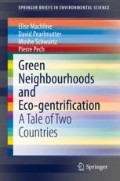Abstract
Following publication of the Brundtland report in 1987, “sustainable development” has become a widely accepted conceptual framework for urban policy and development, providing context for a considerable literature on planning, architecture and urban design (Williams et al. 2000). Debates pitting against nature preservation against development interests were no longer limited to environmental aspects, but began to incorporate economic and social dimensions (Lele 1991) – based on the notion that “environmental quality and economic development are interdependent, and in the long term, mutually reinforcing” (Dampier 1982). More recently, the focus of sustainability on controlling change and growth has been broadened to accommodate the concept of resilience, or the capacity of systems to adapt to changes and recover from disturbance (Ahern 2011).
Access this chapter
Tax calculation will be finalised at checkout
Purchases are for personal use only
Notes
- 1.
The United Nations World Commission on Environment and Development (WCED) in its 1987 report Our Common Future defines sustainable development: “Development that meets the needs of the present, without compromising the ability of future generations to meet their own needs.”
- 2.
The “Bristol Accord”, sets out (1) eight characteristics of a sustainable community; and (i2) contains an agreement to compile good practice case studies that demonstrate sustainable communities’ characteristics to an agreed template.
- 3.
The Aalborg Charter (1994) is an urban environment sustainability initiative approved by the participants of the first European Conference on Sustainable Cities & Towns in Aalborg, Denmark.
- 4.
Agenda 21 is a voluntarily implemented action plan of the United Nations with regard to sustainable development. It is a product of the UN Conference on Environment and Development (UNCED) held in Rio de Janeiro, Brazil, in 1992.
- 5.
The SRU (Urban Solidarity and Town Planning Renewal) Act, 2000: Stipulates that every municipality of more than 3500 residents must include at least 20% of social housing.
- 6.
Translated from French: “Les prix des logements et leur localisation sont-ils adaptés aux capacités financières des profils des ménages?”
References
Ahern, J. (2011). From fail-safe to safe-to-fail: Sustainability and resilience in the new urban world. Landscape and Urban Planning, 100(4), 341–343.
Bristol, A. (2005). Conclusions of ministerial informal on sustainable communities in Europe. Britain: UK Presidency.
Boutaud, A. (2009). Les Agendas 21 locaux. Bilan et perspectives en Europe et en France, Lyon, Grand Lyon. Communauté urbaine Millénaire 3, 56 p.
Canelli, A. (2017). Acteurs et processus décisionnels lors des réhabilitations de friches industrielles - le cas de Hammarby Sjöstad. Recherche de bachelor en Géographie et environnement, Université de Genève.
Certification File (2015). French Ministry of Housing and Sustainable development, Le referentiel ecoquartier 2016.
Chiu, R. (2002). Social equity in housing in the Hong Kong Special Administrative Region: A social sustainability perspective. Sustainable Development, 10, 155–162.
Elsinga, M., & Lind, H. (2013). The effect of EU-legislation on rental systems in Sweden and the Netherlands. Housing Studies, 28(7), 960–970.
Dampier, W. (1982). Ten years after Stockholm: A decade of environmental debate. Ambio, 11(4), 215–231.
EPBD (2002, 2010): Recast, E. P. B. D. (2010). Directive 2010/31/EU of the European Parliament and of the Council of 19 May 2010 on the energy performance of buildings (recast). Official Journal of the European Union, 18(06), 2010.
Haughton, G. (1999). Environmental justice and the sustainable city. In D. Satterthwaite (Ed.), Sustainable cities (pp. 79–62). London: Earthscan.
Holden, E., & Linnerud, K. (2007). The sustainable development area: Satisfying basic needs and safeguarding ecological sustainability. Sustainable Development, 15, 174–185.
Hopwood, B., Mellor, M., & O’Brien, G. (2005). Sustainable development: Mapping different approaches. Sustainable Development, 13, 38–52.
Koester, V. (1980). Nordic countries’ legislation on the environment with special emphasis on conservation: a survey (No. 14). International Union for Conservation of Nature and Natural Resources.
Larsen, H. G., & Hansen, A. L. (2008). Gentrification—gentle or traumatic? Urban renewal policies and socioeconomic transformations in Copenhagen. Urban Studies, 45(12), 2429–2448.
Lele, S. M. (1991). Sustainable development: A critical review. World Development, 19(6), 607–621.
Andrews, D., Sánchez, A. C., & Johansson, Å. (2011). Housing markets and structural policies in OECD countries.
Sanchez, M. (2018). Les relations entre les mesures écologiques et les mesures sociales dans l’écoquartier de Vesterbro à Copenhague, In : Pech P. Écoquartiers et biodiversité. Quel rôle social joue la biodiversité dans les écoquartiers? Paris : Éditions Johanet.
Statistics Sweden, (2018). Average monthly salary, gender and year [Dataset 2018].
Pierson, J. (2002). Tackling social exclusion. London: Routledge.
Tunkrova, L. (2008). The Nordic Countries’‘Exceptionalism’in EU Environmental Policy. Contemporary European Studies, (02), 21–46.
Williams, K., Burton, E., & Jenks, M. (Eds.). (2000). Achieving sustainable urban form. London: Spon.
Author information
Authors and Affiliations
Rights and permissions
Copyright information
© 2020 The Author(s), under exclusive license to Springer Nature Switzerland AG
About this chapter
Cite this chapter
Machline, E., Pearlmutter, D., Schwartz, M., Pech, P. (2020). Green Building in Europe. In: Green Neighbourhoods and Eco-gentrification . SpringerBriefs in Environmental Science. Springer, Cham. https://doi.org/10.1007/978-3-030-38036-6_4
Download citation
DOI: https://doi.org/10.1007/978-3-030-38036-6_4
Published:
Publisher Name: Springer, Cham
Print ISBN: 978-3-030-38035-9
Online ISBN: 978-3-030-38036-6
eBook Packages: Earth and Environmental ScienceEarth and Environmental Science (R0)

